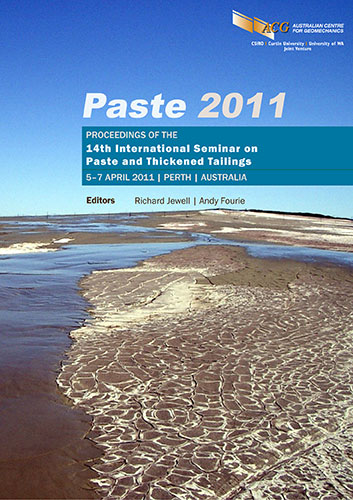Admixtures in backfill applications for cost and performance benefits

|
Authors: Martic, Z; Gelson, JE; Champa, J; Knight, B |
DOI https://doi.org/10.36487/ACG_rep/1104_45_Martic
Cite As:
Martic, Z, Gelson, JE, Champa, J & Knight, B 2011, 'Admixtures in backfill applications for cost and performance benefits', in R Jewell & AB Fourie (eds), Paste 2011: Proceedings of the 14th International Seminar on Paste and Thickened Tailings, Australian Centre for Geomechanics, Perth, pp. 523-536, https://doi.org/10.36487/ACG_rep/1104_45_Martic
Abstract:
The use of chemical admixtures in mining backfill operations is not new historically but the widespread use of chemical admixtures in the backfill industry is still relatively uncommon. The successful use of admixtures in various projects globally is not well documented or known, and this knowledge is basically confined to a very small specific group. These successful references have not facilitated the introduction of admixtures in backfill plants on a regular basis. Various reasons for not using admixtures as an integral part of backfill systems and operations are often related to additional material costs rather than considering the total benefits to the mine, not just the backfill operations. BASF (previously known as Master Builders) showed in the early 1990s that certain properties of the fill can be significantly improved by the use of chemical admixtures. What was not followed or expanded upon were the benefits to the mine of the backfill mix design in terms of rheology, strength increase, reduced pipeline pressures and potential binder savings. At that time, often the instrumentation and monitoring of backfill was relatively unsophisticated and hence improvements were hard to quantify. With the use of modern transducers, sensors, flow meters etc., key parameters are much easier to quantify, and hence show the potential greater benefits of admixtures in backfill mixes to the total mining system. The paper sets out to show the benefits from the use of chemical admixtures in backfill mixes, and through case histories and measurements, quantify the real improvements both physical and financial for the backfill industry. It will also show how a backfill admixture can be a useful tool to improve various parameters of the fill. The authors’ aim in this paper is to hopefully show a creative method and approach to using admixtures in a backfill system rather than to simply discuss the results of a particular admixture application.
References:
Archibald, J.F., DeGagné, D.O., Lausch, P. and De Souza, E.M. (1995) Ground waste glass as a pozzolanic consolidation agent for mine backfill, CIM Bulletin, Vol. 88, No. 909, pp. 80–87.
ASTM C 230-90 (1997) Standard specification for Flow Table for use in Tests of Hydraulic Cement, 1997 Annual Book of ASTM Standards, American Society for Testing and Materials (ASTM), Philadelphia Vol. 04.01,
pp. 182–186.
ASTM C 143/143M-10a Standard test method for slump of hydraulic-cement concrete, in Annual Book of ASTM Standards, American Society for Testing and Materials (ASTM), Philadelphia, Vol. 04.02.
Aylmer, F.L. (1973) Cement properties related to the behaviour of cemented fill, in Proceedings Jubilee Symposium on Mine Filling, Mount Isa, North West Queensland Branch, The AusIMM, August, pp. 59–63.
Belem, T. and Benzaazoua, M. (2007) Design and application of underground mine paste fill technology, Geotechnical and Geological Engineering, Vol. 26, No. 2, pp. 147–174.
Donovan, J., Dawson, J. and Bawden, W.F. (2007) David Bell Mine Underhand Cut and Fill Sill Mat Test, Minefill 2007 Symposium, April 29 – May 3, Montreal, Quebec, Canada.
Farzam, H., Rispin, M. and Karlson, R. (1998) The Use of Unique Admixture Technologies in Mining Backfill - Technology Description and Case Histories, Minefill 98, in Proceedings Sixth International Symposium on Mining with Backfill, AusIMM, Carlton Victoria, pp. 71–75.
Gay, F. and Constantiner, D. (1998) Additives for improving paste backfill mixes, Tailings and Mine Waste ’98, in Proceedings 5th International Conference, Fort Collins, Colorado, 26–28 January, A.A. Balkema, Rotterdam, The Netherlands, pp. 159–166.
Klein, K. and Simon, D. (2006a) Effect of specimen composition on the strength development in cemented paste backfill, Canadian Geotechnical Journal, NRC Research Press, Journal 43, pp. 310–324.
Klein, K. and Simon, D. (2006b) Electromagnetic properties of cemented paste backfill, Journal of Environmental and Engineering Geophysics, GeoScienceWorld, Vol. 11, pp. 27–41.
Nieminen, P. and Seppanen, P. (1983) The use of blast-furnace slag and other by-products as binding agents in consolidated backfilling at Outokumpu Oy’s mine, in Proceedings International Symposium of Mining with Backfill, Luleå, Balkema, Rotterdam, 7–9 June, pp. 49–58.
Ramachandran, V.S. (1995) Concrete Admixtures Handbook, Properties, Science, and Technology, Second Edition, Noyes Publications, Park Ridge, New Jersey, pp. 286–506; 994–1006.
Thomas, E.G. (1973) A review of cementing agents for hydraulic fill, in Proceedings Jubilee Symposium on Mine Filling, Mount Isa, North West Queensland Branch, The AusIMM, August, pp. 65–75.
Yu, T.R. and Counter, D.B. (1988) Use of fly ash in backfill at Kidd Creek Mines, CIM Bulletin, Vol. 81, No. 909, pp. 44–50.
Wang, C., Padrutt, A. and Millette, D. (2002) Improvement of cemented backfill properties by using admixtures, in Proceedings 7th Annual GSE Symposium – Geotechnique in The Mining Industry, March.
© Copyright 2024, Australian Centre for Geomechanics (ACG), The University of Western Australia. All rights reserved.
View copyright/legal information
Please direct any queries or error reports to repository-acg@uwa.edu.au
View copyright/legal information
Please direct any queries or error reports to repository-acg@uwa.edu.au